What is Crowdfunding?
Best crowdfunding platforms has become one of the most efficient ways to raise money for projects, businesses, and causes in 2024. It’s a method of fundraising that allows individuals or organizations to gather financial contributions from a large number of people—usually through an online platform. Crowdfunding platforms provide creators, entrepreneurs, and nonprofits with an accessible way to reach a global audience, turning ideas into reality without relying on traditional investors or loans.
The process is simple: creators pitch their idea on a crowdfunding platform, set a funding goal, and backers contribute money to support the project. In exchange, backers might receive rewards, a product, or even equity, depending on the type of crowdfunding. This direct connection between creators and supporters has fueled the popularity of crowdfunding platforms, making it a valuable tool for anyone looking to launch a product, fund a creative project, or support a cause.
In recent years, crowdfunding has surged because it democratizes funding. Anyone with a compelling idea can now access capital, which was previously reserved for those with connections to traditional investors or banks. Platforms like Kickstarter, Indiegogo, and GoFundMe have played a pivotal role in expanding this market. For creators and entrepreneurs, the question is no longer “Can I get funded?” but rather “What is the best crowdfunding platform for my project?”
Whether you’re pre-selling a product or raising money for a personal cause, the best crowdfunding platforms of 2024 offer tailored experiences that fit different needs. From creative projects to ongoing creator support, crowdfunding is an essential tool for modern creators.
Types of Crowdfunding Platforms
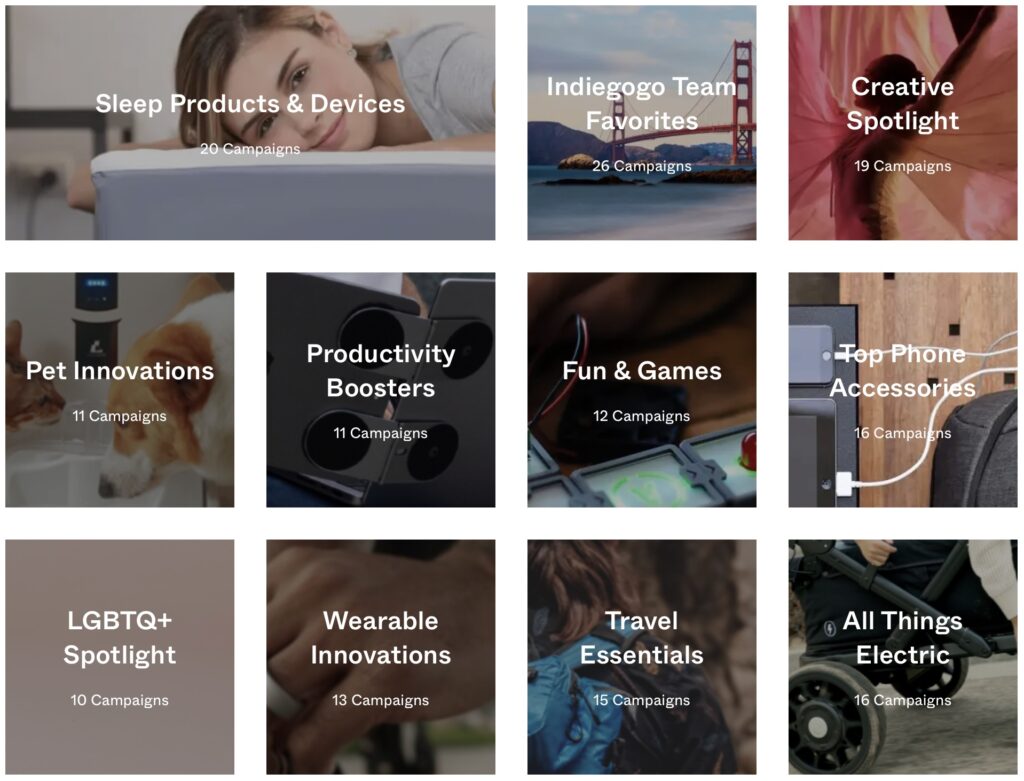
Not all crowdfunding platforms work the same way. There are different types depending on what you’re raising money for and how you want to reward your backers. The main types of crowdfunding are donation-based, rewards-based, equity-based, and debt-based (also called peer-to-peer lending).
Donation-based crowdfunding is the simplest. People give money, and they don’t expect anything in return. It’s popular for charities or personal causes like medical expenses. Platforms like GoFundMe are built for this.
Rewards-based crowdfunding offers backers something in return for their money, but not equity. You might offer early access to a product, a shout-out, or some kind of exclusive content. This is what platforms like Kickstarter and Indiegogo specialize in. It’s great for creators and entrepreneurs who want to pre-sell an idea or product before it’s fully built.
Equity-based crowdfunding is more serious. Instead of a product, backers get a piece of your business. They’re not just donating; they’re investing. This type is growing fast, especially with platforms like StartEngine. For entrepreneurs, this means giving up some control of your company in exchange for funding.
Debt-based crowdfunding works like a loan. You borrow money from a group of people and pay them back with interest. It’s a good option for businesses that don’t want to give up equity. Companies like LendingClub and Funding Circle are leaders in this space.
Choosing the right type of crowdfunding depends on your goals. Do you want to build a community around your idea, or are you just trying to get the cash you need to get started? Each platform has its strengths, so it’s important to understand which one fits your project best.
How Crowdfunding Platforms Are Used by Consumers
Crowdfunding is incredibly flexible, which is why it appeals to so many different people. Creators use it to fund passion projects. Entrepreneurs use it to launch new businesses. Nonprofits use it to raise money for causes. No matter who you are, crowdfunding offers a way to turn ideas into reality by tapping into the support of a community.
For creators, especially those in media—photographers, filmmakers, musicians—it’s a great way to test out ideas and engage with fans. Platforms like Patreon allow creators to build ongoing relationships with their supporters, who pay monthly for access to exclusive content. This turns fans into financial backers, allowing creators to focus on their art without worrying about traditional funding.
Entrepreneurs use platforms like Kickstarter or Indiegogo to validate their products before they even launch. Imagine testing the demand for a product by raising the funds to build it. If people are willing to pay upfront, it’s a sign that the idea has legs. Crowdfunding also creates buzz, helping businesses build an audience before they even have a product on the shelves.
For nonprofits, crowdfunding makes it easier to reach more people and raise money quickly. GoFundMe is a popular platform for personal and charitable campaigns, and it’s used by both small grassroots efforts and large-scale fundraising campaigns.
Consumers are drawn to crowdfunding because it allows them to support projects they believe in, and in many cases, get something in return—whether it’s a new product, exclusive content, or simply the satisfaction of helping a cause. Crowdfunding also gives them a chance to be part of something new and exciting. They’re not just customers; they’re contributors to a bigger vision.
Crowdfunding Market Growth in 2024
Crowdfunding has rapidly grown into a multi-billion-dollar industry, and the numbers for 2024 look impressive. The global crowdfunding market was valued at $19.86 billion in 2023 and is projected to reach $72.88 billion by 2032. This represents a compound annual growth rate (CAGR) of 16.1% from 2024 to 2032, demonstrating the growing appeal of crowdfunding across multiple sectors.
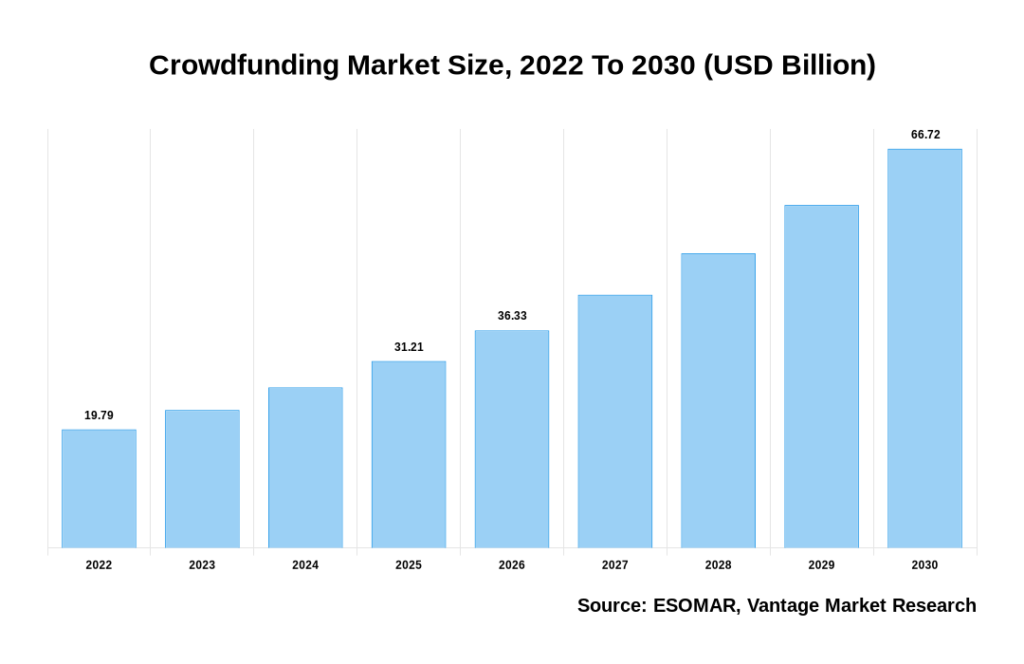
Several factors are driving this growth. First, the integration of advanced technologies like artificial intelligence and machine learning has made it easier for platforms to personalize the experience for both creators and backers. Platforms are now able to analyze trends and user behavior, helping creators optimize their campaigns in real time.
Additionally, the rise of social media has boosted the visibility of crowdfunding campaigns. Platforms like Instagram, Twitter, and LinkedIn have become powerful tools for spreading the word, enabling campaigns to go viral and reach global audiences.
The healthcare sector, in particular, has seen significant use of crowdfunding. Many campaigns are focused on raising funds for medical treatments, research, and even surgeries, proving how versatile and impactful this model can be across industries.
As more entrepreneurs and creators realize the potential of crowdfunding, the market is expected to continue its upward trajectory, making it a crucial player in global fundraising strategies.
Top 5 Crowdfunding Platforms in 2024
When it comes to choosing the best crowdfunding platforms, there are a few names that consistently rise to the top. These platforms not only offer the tools you need to launch a campaign but also have proven track records of success. In 2024, the top five platforms stand out due to their size, reach, and ability to help creators and entrepreneurs achieve their goals.
Kickstarter
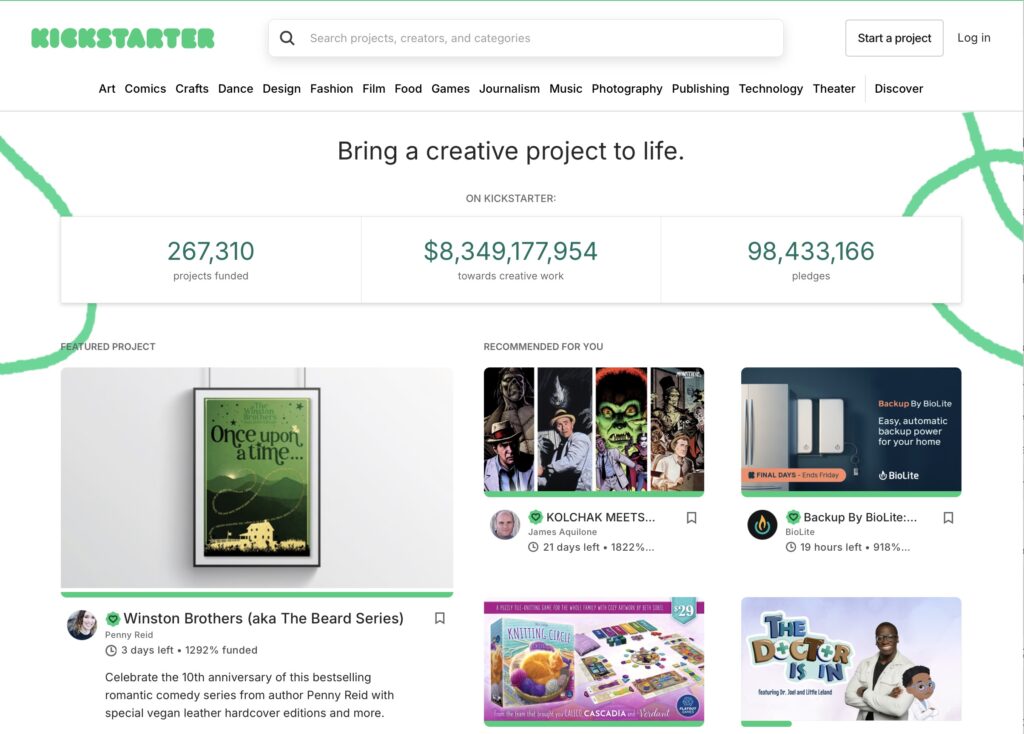
Kickstarter is one of the top choices among the best crowdfunding platforms in 2024. Here’s why it stands out, as well as the challenges creators might face:
Advantages
- Massive Audience: Kickstarter is one of the largest and best crowdfunding platforms, boasting millions of users who are actively seeking out new projects to support. As a creator, this gives you instant access to a built-in audience, helping your project gain visibility right from the start. This is especially helpful if you’re new to crowdfunding and want a platform with high traffic.
- All-or-Nothing Funding: While this model can be a double-edged sword, it ensures that creators only move forward if they raise enough money to complete their project. This eliminates the risk of launching with insufficient funds, which can lead to delays and dissatisfaction from backers. From a creator’s standpoint, this makes budgeting easier and reduces stress about delivering a half-finished product.
- Community Building: One of the unique strengths of Kickstarter is how it allows creators to build a community around their project. Backers aren’t just investors; they become advocates. Through regular updates, creators can engage with their audience, which often leads to increased visibility through word-of-mouth and social media sharing. Many creators leverage this aspect to generate ongoing interest and support.
- Market Validation: Kickstarter is not just about raising funds—it’s also a way to test if there’s demand for your idea. Creators can use Kickstarter to gauge interest in their product or concept before committing to large-scale production. This makes it one of the best crowdfunding platforms for entrepreneurs looking to minimize risk while validating their ideas.

Challenges
- High Competition: While the large user base is a plus, it also means competition is fierce. Thousands of projects are live at any given moment, so standing out is a challenge. Successful campaigns often require a strong marketing plan, social media presence, and an initial audience ready to pledge right away to create momentum.
- Time Commitment: Running a campaign on Kickstarter is time-intensive. Creators need to be prepared to spend significant time promoting the campaign, answering backers’ questions, and providing regular updates. Without continuous effort, even promising campaigns can lose steam.
- Fees: Like other best crowdfunding platforms, Kickstarter takes a cut. It charges a 5% platform fee, and payment processing fees range from 3% to 5%. While these fees are standard in the industry, creators need to factor them into their fundraising goal to ensure they raise enough after deductions.
- Strict Guidelines: Kickstarter has specific rules about what kinds of projects are allowed. Certain categories, like personal loans or charitable fundraising, are not permitted. Creators need to ensure their project fits within the platform’s guidelines, or they risk having their campaign rejected.
Kickstarter remains one of the best crowdfunding platforms for creators in 2024, offering unparalleled reach and the ability to engage deeply with an audience. Its all-or-nothing model and the emphasis on community-building make it ideal for creators who want to both fund their project and build long-term support. However, it requires careful planning, a solid marketing strategy, and ongoing effort to ensure success. For those willing to invest the time and energy, Kickstarter can be an invaluable tool in bringing ideas to life.
Indiegogo
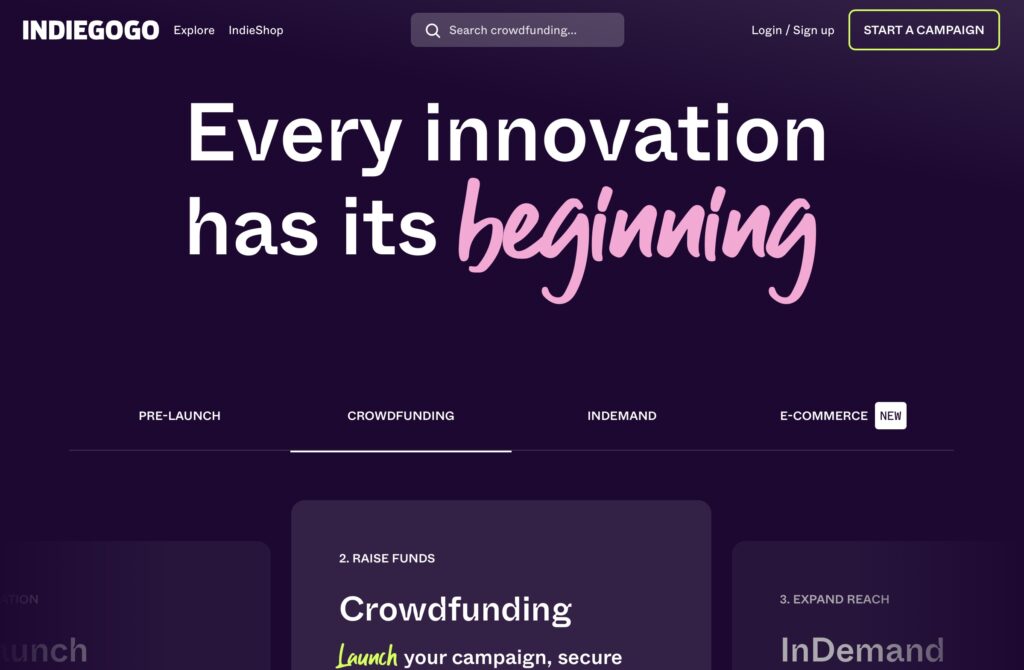
Indiegogo offers a bit more flexibility compared to Kickstarter. It allows creators to run both all-or-nothing and flexible funding campaigns, where they keep whatever funds are raised, regardless of hitting the goal. This makes it attractive for entrepreneurs who want more control over their campaigns. Indiegogo is known for its strong focus on tech gadgets and innovative products. In 2024, the platform is growing as more startups use it to test product-market fit before full-scale launches.
Advantages
- Flexible Funding Options: One of the biggest advantages of Indiegogo over other crowdfunding platforms is its flexibility. Unlike Kickstarter’s all-or-nothing approach, Indiegogo offers both fixed and flexible funding options. With flexible funding, creators get to keep the money they’ve raised, even if they don’t meet their goal. This is beneficial for creators who might still be able to deliver on their project with partial funding or who prefer a lower-risk option.
- Broader Project Categories: Indiegogo is more lenient in terms of the types of projects it allows. This makes it suitable for a wider range of creators, especially those who may not fit into Kickstarter’s stricter project categories. Whether you’re raising money for a new product, a charity cause, or even a social campaign, Indiegogo has fewer restrictions, making it an inclusive platform for diverse creators.
- InDemand Feature: Indiegogo offers a unique InDemand feature that allows creators to continue raising funds even after their campaign ends, something not typically available on other best crowdfunding platforms. This is a significant advantage for creators who want to keep the momentum going and continue collecting funds after the initial campaign period.
- Global Reach: Indiegogo’s international focus makes it a go-to for creators outside of the U.S. The platform supports various currencies, languages, and payment options, giving creators from different countries a chance to tap into global backers without unnecessary barriers. This is particularly useful for entrepreneurs and creators looking to expand their reach beyond their local markets.
- Strong Support for Tech Projects: Indiegogo is especially popular among tech and hardware startups, offering tools and advice for product creators. The platform provides resources to help with prototyping, manufacturing, and marketing, making it a top choice for creators launching new gadgets or innovative products.

Challenges
- Fees: Like other best crowdfunding platforms, Indiegogo charges fees. It takes 5% of funds raised, plus additional payment processing fees of 3% to 5%. While these are standard fees in the industry, creators should account for them when setting their funding goals.
- Success Rates: Indiegogo’s flexible funding model can be a double-edged sword. While it gives creators the benefit of keeping funds raised, it also means that backers might be less motivated to pledge early or aggressively since there’s no all-or-nothing urgency. This can sometimes lead to lower overall campaign performance compared to platforms like Kickstarter, which thrives on that tension.
- Marketing Effort: Like most crowdfunding platforms, marketing is key to a successful Indiegogo campaign. Creators cannot rely on the platform alone to generate backers. Without a strong marketing push, projects can quickly get lost among the thousands of active campaigns. This means creators must be prepared to invest significant time and effort in promoting their project, both before and during the campaign.
- Competition: While Indiegogo offers a wide range of categories, this also means creators face stiff competition, especially in popular categories like technology and gadgets. Standing out requires a well-thought-out campaign, compelling visuals, and a clear value proposition for backers.
GoFundMe
GoFundMe dominates the donation-based crowdfunding space. It’s the go-to platform for personal causes and charitable fundraising, making it incredibly popular for nonprofits and individuals seeking help with medical bills, education, and emergencies. What sets GoFundMe apart is its zero platform fees for personal campaigns, although transaction fees still apply. With over $15 billion raised to date, it’s a key player in the crowdfunding industry in 2024.
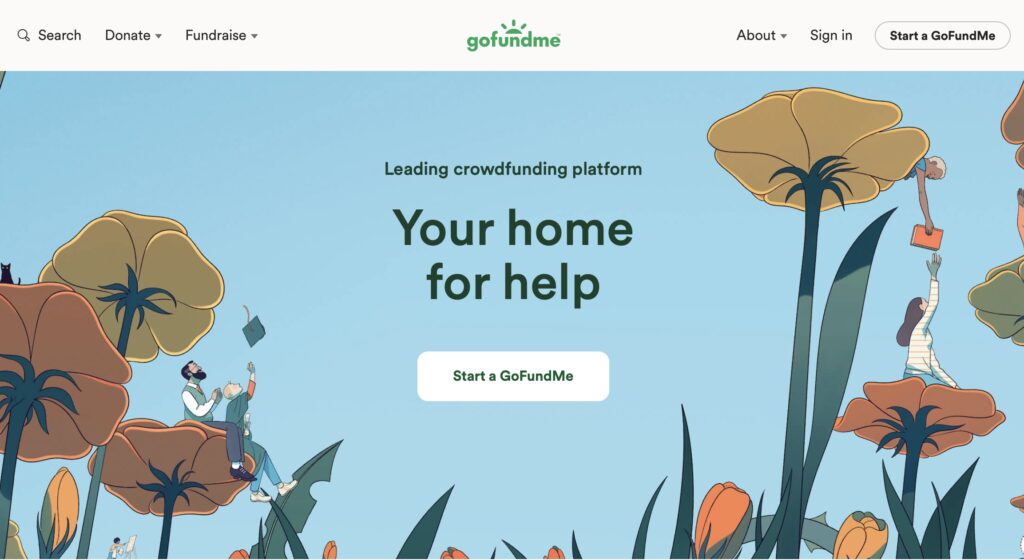
Advantages
- No Platform Fees for Personal Campaigns: One of the standout features of GoFundMe is its zero platform feesfor personal fundraising campaigns. Creators only pay the standard payment processing fees (around 2.9% + $0.30 per transaction), allowing more of the funds raised to go directly to the cause. This is a major advantage over other best crowdfunding platforms where platform fees can add up significantly.
- Easy to Use: GoFundMe is known for its simple and user-friendly interface, making it easy for anyone to set up a campaign quickly. This is especially important for creators who are not experienced in managing complex crowdfunding campaigns. The platform provides clear guidance on how to set up your page, share your story, and start receiving donations.
- Mass Appeal for Personal Causes: GoFundMe is widely recognized for personal causes, such as medical bills, emergencies, or education funds. It has helped millions of people raise money for urgent needs. For creators focused on raising funds for life events or emergencies, GoFundMe is often seen as the most credible and trusted platform, which can help attract more donors who are familiar with its reputation.
- Global Reach: GoFundMe supports campaigns from many countries, allowing creators to reach a global audience. This international appeal is important for those looking to tap into a wider network of potential donors, especially for causes that resonate across borders, such as humanitarian or disaster relief efforts.
- Trust and Transparency: GoFundMe places a strong emphasis on building trust between creators and donors. It offers a GoFundMe Guarantee, which protects donors in case of fraud or misuse of funds. This creates a sense of security for backers, which can encourage more donations.
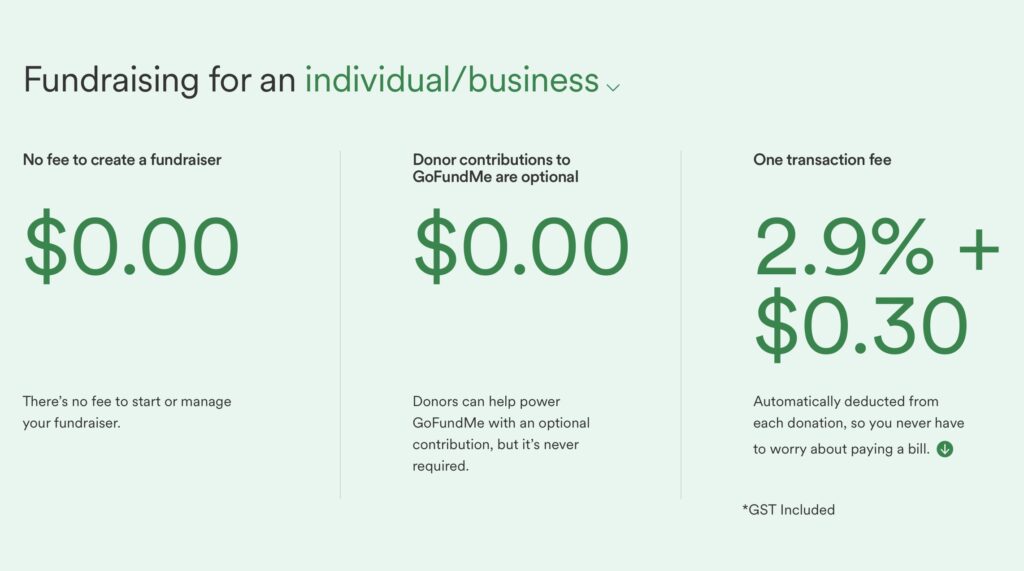
Challenges
- Limited to Donations: GoFundMe is a donation-based platform, which means it doesn’t offer creators the ability to provide rewards or equity in exchange for funding. This limits its appeal for entrepreneurs or creators who are looking to offer tangible incentives to backers, a common feature of other best crowdfunding platforms like Kickstarter or Indiegogo.
- Payment Processing Fees: While GoFundMe doesn’t charge platform fees for personal campaigns, the payment processing fees of 2.9% + $0.30 per donation still apply. For campaigns that raise significant amounts, these fees can add up, reducing the total amount creators receive.
- No Pre-Sale or Product Focus: GoFundMe is not the platform for creators looking to pre-sell products or gauge market interest in a new venture. Its focus is entirely on donation-based fundraising, which is best suited for personal needs, charities, and nonprofits. Creators looking for business funding or product validation will likely find platforms like Kickstarter more suitable.
- Competition and Visibility: While GoFundMe is a popular platform, this can also be a drawback. With so many active campaigns, it can be challenging for creators to stand out and get noticed, especially without a strong personal network or a compelling story that resonates with a broader audience.
Patreon
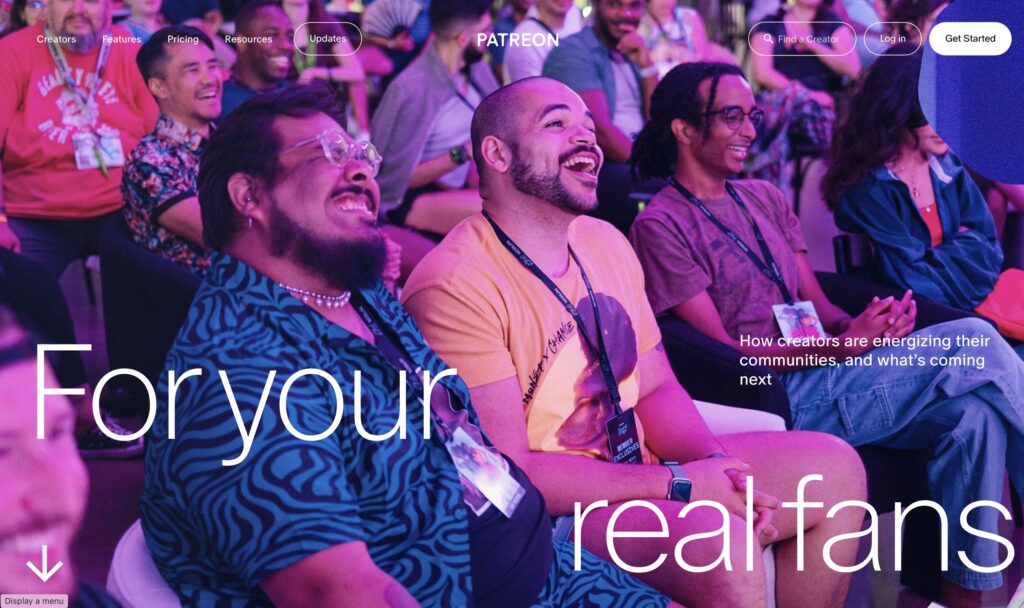
Patreon is unique among crowdfunding platforms because it focuses on ongoing support rather than one-time campaigns. Creators—like podcasters, artists, and YouTubers—use Patreon to build subscription-based relationships with their audiences. Supporters pledge monthly to get exclusive content and perks. In 2024, Patreon continues to be a critical tool for content creators who want to build sustainable incomes while deepening their connection with their fanbases.
Advantages
- Ongoing Support: Unlike platforms like Kickstarter or Indiegogo, which focus on one-time funding for specific projects, Patreon allows creators to build recurring income. Supporters, or “patrons,” pledge a set amount each month in exchange for ongoing rewards or exclusive content. This makes Patreon ideal for creators like YouTubers, podcasters, artists, and musicians who produce regular content. The ability to rely on consistent monthly income is a game-changer for creators trying to make a living from their work.
- Direct Connection with Fans: Patreon is built around fostering a deeper relationship between creators and their fans. Creators can offer exclusive perks such as behind-the-scenes content, early access to videos, personalized shoutouts, or even one-on-one interactions. This type of engagement helps creators build a loyal community of backers, turning casual followers into dedicated supporters.
- Customizable Tiers: One of the unique features of Patreon is the ability to create membership tiers, where patrons can choose different levels of support in exchange for increasingly valuable rewards. This flexibility lets creators cater to all levels of backers, from casual supporters to those who want more exclusive experiences. Creators can tailor their content and rewards to the interests of their most loyal fans.
- Low Risk, High Control: Patreon provides a low-risk model for creators since it doesn’t require them to meet specific funding goals or deadlines. Creators can launch their Patreon pages at any time and build support gradually. There’s also more creative control compared to project-based platforms, allowing creators to continue focusing on what they do best without needing to pitch or justify each new project.
- Community Building: For many creators, Patreon serves as more than just a source of income. It also functions as a community hub, where fans can connect not only with the creator but also with each other. Patreon’s platform supports direct communication through updates, comments, and private messages, allowing for more meaningful interactions.
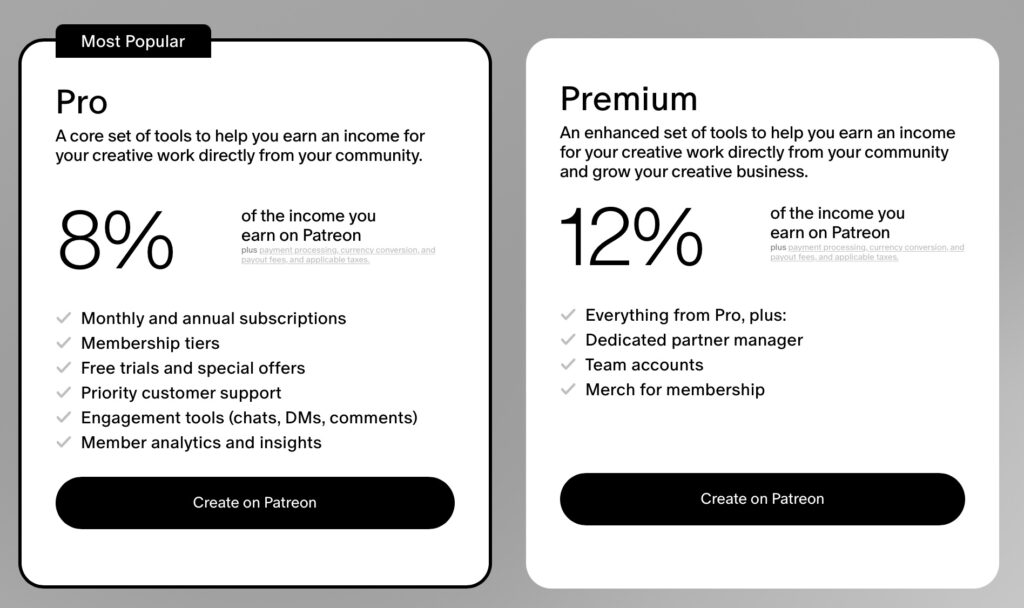
Challenges
- Marketing Effort: While Patreon is one of the best crowdfunding platforms for ongoing support, it requires constant promotion. Creators cannot rely solely on Patreon’s platform to grow their subscriber base—they need to actively market their Patreon page across other social media platforms, email lists, and personal networks. Building an audience can take time and requires sustained effort to keep patrons engaged and excited.
- Fees: Patreon charges a percentage of creators’ earnings, with fees ranging from 5% to 12% of monthly income, depending on the plan chosen (Lite, Pro, or Premium). In addition, payment processing fees of around 2.9% + $0.30 per transaction also apply. While the fees are standard for crowdfunding platforms, creators should be aware of them when calculating their potential earnings.
- Constant Content Production: Patreon works best for creators who produce consistent, ongoing content. This can be challenging for those who are not used to creating regularly or for creators whose projects take longer to complete. Without fresh content, it can be difficult to keep patrons engaged and maintain monthly pledges.
- Retention of Patrons: One challenge specific to Patreon is the need to retain patrons over time. Since the platform is based on monthly subscriptions, creators need to continually provide value to keep their supporters from dropping off. If patrons don’t feel they’re getting enough exclusive content or rewards, they may cancel their pledge. This means creators need to carefully balance their workload between content creation and patron engagement.
Givebutter
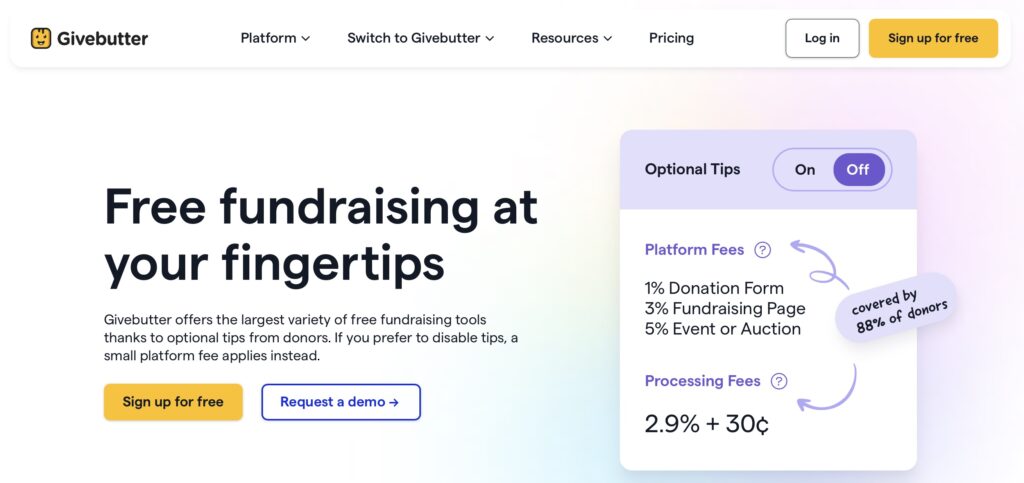
Givebutter is quickly gaining traction as a versatile platform that combines traditional crowdfunding with tools for events, donations, and peer-to-peer fundraising. It’s a favorite among nonprofits, small businesses, and individuals who want an all-in-one platform for raising money. With no platform fees and only minimal transaction fees, Givebutter has made it easy for campaigns to keep more of what they raise. In 2024, it’s poised to continue growing, thanks to its user-friendly interface and robust set of features for event fundraising.
Advantages
- Completely Free for Creators: One of the standout features of Givebutter is that it has no platform fees. Creators and organizations can raise funds without worrying about losing a portion to the platform itself. Instead, Givebutter operates on a “tip” model, where donors have the option to leave a tip for the platform. This makes it one of the most affordable and accessible crowdfunding platforms for both creators and nonprofits.
- Versatile Fundraising Tools: Givebutter offers a variety of fundraising tools that go beyond traditional crowdfunding. It supports donations, events, and peer-to-peer fundraising all in one place. Creators can host live fundraising events, sell tickets, and even set up donation forms on their own websites. This makes Givebutter ideal for creators or organizations that need more than just basic crowdfunding features.
- Live Streaming Integration: Givebutter includes built-in support for live streaming, making it a unique platform for creators who want to engage with their audiences in real time. This feature is particularly useful for creators who want to host virtual events, such as benefit concerts or online auctions, while simultaneously raising money.
- Donor-Friendly: Givebutter is highly focused on donor engagement. It allows donors to contribute using a variety of payment methods, including credit cards, PayPal, Venmo, and even cryptocurrency. The platform also emphasizes transparency by allowing donors to see exactly where their money goes, creating a strong sense of trust and accountability.
- Social Media Integration: The platform excels in its ability to integrate with social media, allowing creators to easily share campaigns across platforms like Facebook, Instagram, and Twitter. This built-in functionality helps campaigns go viral, attracting more donors and spreading awareness faster than many other best crowdfunding platforms.
- Customizable Campaign Pages: Givebutter allows creators to fully customize their campaign pages with their own branding, colors, and messaging. This flexibility is useful for creators who want their campaigns to feel like an extension of their brand or organization, rather than a generic crowdfunding page.
Challenges
- Primarily Nonprofit-Focused: While Givebutter is one of the best crowdfunding platforms for nonprofits and social causes, its focus on charitable fundraising may make it less appealing for creators looking to fund personal or business ventures. Creators looking to pre-sell products or raise equity might find more suitable options on platforms like Kickstarter or Indiegogo.
- Reliance on Tips: Although there are no platform fees, the tip-based model means Givebutter relies on donors voluntarily adding a tip to their donations. This is a great model for donors who are willing, but it also means that the platform’s sustainability is tied to this feature, which may impact long-term stability or the development of new features.
- No Advanced Equity or Reward-Based Options: Unlike platforms like Patreon or StartEngine, Givebutter is more focused on donation-based and peer-to-peer fundraising. For creators looking to offer equity or reward-based crowdfunding, Givebutter might not be the right fit. Its tools are more tailored for social causes and event-driven campaigns.
- Niche Audience: Because of its focus on nonprofit fundraising and donation-based campaigns, Givebutter might not attract the same broad audience that platforms like GoFundMe or Indiegogo do. Creators seeking a large, diverse backer pool for commercial products may find their audience is more limited here.
Comparison of the Best Crowdfunding Platforms
When it comes to choosing the best crowdfunding platform in 2024, creators and entrepreneurs have plenty of options. Each platform offers distinct advantages depending on the type of project, funding goals, and audience engagement. Whether you’re looking to pre-sell a product, raise money for a cause, or build a long-term revenue stream, selecting the right platform is key. Below is a comparison table outlining the most important criteria, including funding models, fees, audience focus, and unique features, to help you find the best fit for your crowdfunding needs.
| Criteria | Kickstarter | Indiegogo | GoFundMe | Patreon | Givebutter |
| Funding Model | All-or-nothing | Flexible and all-or-nothing | Donation-based | Recurring (monthly subscriptions) | Donation-based, peer-to-peer, and event fundraising |
| Platform Fees | 5% | 5% | 0% (personal campaigns, but transaction fees apply) | 5%-12% (depending on plan) | 0% (rely on optional donor tips) |
| Payment Processing Fees | 3% + $0.20 | 3%-5% | 2.9% + $0.30 | 2.9% + $0.30 | 2.9% + $0.30 |
| Best Use Cases | Pre-selling products, creative projects | Tech and innovative products, flexible funding | Personal causes, charity | Ongoing support for creators (artists, musicians) | Nonprofit fundraising, peer-to-peer, event fundraising |
| Audience Focus | Creative projects, entrepreneurs | Entrepreneurs, tech startups | Individuals, nonprofits | Artists, musicians, podcasters, content creators | Nonprofits, small businesses, social causes |
| Global Reach | Yes | Yes | Yes | Yes | Yes |
| Customizability | Limited to platform format | Flexible in funding options | Basic campaign setup | Membership tiers | Fully customizable campaign pages |
| Unique Features | All-or-nothing model encourages urgency | InDemand allows ongoing funding after campaign ends | GoFundMe Guarantee (fraud protection for donors) | Ongoing subscription model with tiered rewards | Live streaming support, events, no platform fees |
| Community Engagement | Updates and comments from backers | Flexible communication with backers | Donor engagement through updates | Direct interaction with patrons, private content | Built-in social media and donor engagement tools |
| Marketing Effort Required | High—requires significant pre-launch promotion | High—requires strong marketing to stand out | Moderate—success relies on personal networks | High—requires consistent content production | Moderate—strong social media integration |
| Overall Best For | Entrepreneurs and creators with specific projects | Flexible funding for entrepreneurs and tech startups | Personal fundraising, charity | Ongoing creator support and engagement | Nonprofits, social causes, event-driven campaigns |
Key Takeaways:
- Kickstarter is best for creators with defined goals who are comfortable with all-or-nothing funding, especially for creative or tech projects.
- Indiegogo offers more flexibility in funding, making it a great option for tech startups or entrepreneurs who want a less rigid funding model.
- GoFundMe excels for personal fundraising and nonprofit causes with its fee-free platform for personal campaigns and strong donor trust.
- Patreon is designed for creators who produce ongoing content and want to build sustainable, recurring income through memberships.
- Givebutter is a versatile option for nonprofits and small businesses, with its live streaming capabilities, customizable pages, and no platform fees.
Each platform has its own strengths, so creators and entrepreneurs should choose based on their specific needs, whether it’s ongoing support, pre-selling products, or charitable fundraising.
Performance of Crowdfunding Platforms
When we talk about the best crowdfunding platforms in 2024, it’s not just about which platform is the most popular or has raised the most money. It’s about how they perform for creators and entrepreneurs. Performance can be measured by various factors: revenue models, fees, and how well platforms serve their specific niches.
One major factor creators need to consider is fees. Most platforms take a percentage of the funds raised as a commission, and these fees can add up quickly. For example, Kickstarter and Indiegogo both take a 5% cut of funds raised, with additional processing fees ranging between 3% and 5%. GoFundMe, while famous for personal causes, doesn’t charge a platform fee for personal campaigns but still takes processing fees. Meanwhile, Patreon offers tiered plans ranging from 5% to 12%, which could be seen as more expensive, but that’s offset by its potential for consistent, monthly revenue for creators producing ongoing content.
Beyond fees, financial performance is another important metric. Platforms like Kickstarter and Indiegogo tend to dominate the tech and creative spaces due to their broad reach. But that doesn’t necessarily mean they perform better across all categories. For instance, Patreon is excellent for creators who need regular income, as it focuses on building a loyal, long-term audience that supports monthly. Meanwhile, GoFundMe has cornered the market for personal and emergency funding, making it the go-to for those raising money for causes, medical bills, or personal needs.
The platforms’ performance in specific niches is also worth noting. While Kickstarter excels in product launches and creative projects, Patreon shines for creators offering ongoing content like videos or podcasts. Platforms like Givebutterare outperforming others in the nonprofit sector, thanks to their no-platform-fee model and wide range of fundraising tools, including live events and peer-to-peer campaigns.
What becomes clear when comparing these platforms is that performance is not just about who raises the most money. It’s about who serves their users best, whether that means supporting a one-time product launch, building an ongoing revenue stream, or raising funds for personal causes. The key is understanding how each platform aligns with the goals of your project or business.
Why Choose Scrile Connect for Your Crowdfunding Business
When it comes to building a crowdfunding business, one size rarely fits all. That’s where Scrile Connect steps in. Unlike the major platforms like Kickstarter or Indiegogo, Scrile Connect offers a unique opportunity: the ability to create your own white-label crowdfunding platform. This means you can launch your own branded site, fully customized to meet the specific needs of your business or community. Instead of relying on the rules and limitations of third-party platforms, you control every aspect of your crowdfunding environment.
With Scrile Connect, you aren’t just limited to one type of crowdfunding. Whether it’s donation-based, reward-based, or even equity crowdfunding, the platform is flexible enough to support whatever your business model demands. This is especially valuable for entrepreneurs and creators looking for more control over their campaigns, branding, and user experience.
Another reason to consider Scrile Connect is its customization options. You can personalize every element, from the user interface to the backend features, so it aligns with your niche or target audience. Whether you are a content creator looking to monetize exclusive access or a business launching a new product, Scrile Connect allows you to integrate all the features you need—without sacrificing your brand identity.
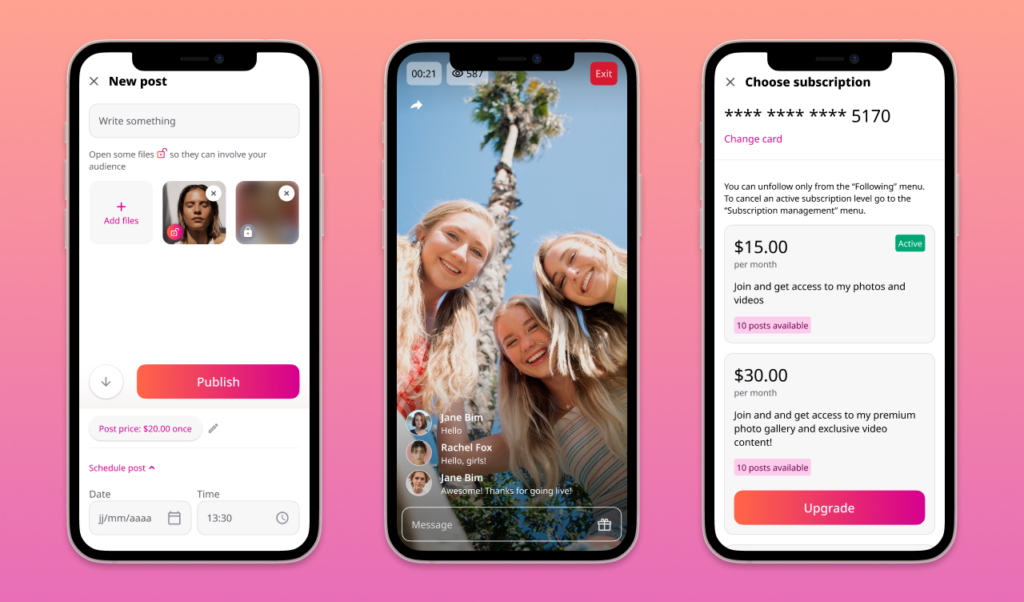
Scalability is another key advantage. As your crowdfunding project grows, Scrile Connect grows with you. You can start with basic features and gradually add more as your user base expands. This flexibility makes it an ideal platform for creators and entrepreneurs looking to scale their business over time without the worry of outgrowing the system.
Finally, because Scrile Connect is run by an IT company with expertise in custom development, you’re not limited to off-the-shelf solutions. They can build out additional features, integrations, or tools that suit your exact requirements. This is especially important in a market where trends and technologies evolve quickly.
Choosing Scrile Connect is not just about launching a crowdfunding business—it’s about owning it. By having complete control over the platform, its features, and its design, you ensure that your business stands out in the rapidly growing crowdfunding market.
Growing Your Own Crowdfunding Business in 2024
In 2024, the crowdfunding market is showing no signs of slowing down, and that presents a huge opportunity for entrepreneurs who want to build their own platforms. The market for crowdfunding is projected to reach billions in the coming years, driven by the increasing popularity of digital platforms, social media, and peer-to-peer transactions. Whether you’re an entrepreneur, a content creator, or a business owner, now is the perfect time to launch your own crowdfunding platform and tap into this growing market.
One of the key benefits of starting your own crowdfunding platform is the ability to cater to niche markets. While established platforms like Kickstarter and Indiegogo focus on broad categories, a custom-built platform allows you to target specific audiences, whether it’s for creative projects, charitable causes, or equity investments. With a more focused approach, you can offer tailored experiences and build a community that feels more connected to your brand and mission.
Additionally, launching your own platform gives you full control over branding, functionality, and user experience. You’re not subject to the rules and regulations of third-party platforms, and you won’t have to worry about competing for attention in a crowded marketplace. Instead, you can build a dedicated space where your audience feels engaged and supported.
Another important factor to consider is the scalability of your platform. As crowdfunding continues to grow, so will the need for platforms that offer unique features and seamless user experiences. With a solution like Scrile Connect, you can start small and add features as your platform grows. From handling large campaigns to integrating new technologies like AI or blockchain, having your own platform allows you to stay ahead of industry trends and meet the evolving needs of your users.
Starting your own crowdfunding business also opens up multiple revenue streams. Beyond standard campaign commissions, you can offer premium services, custom features, and even charge for added exposure on your platform. The potential for monetization is far greater when you control the platform and its various functionalities.
Now is the perfect time to enter the crowdfunding space. The barriers to entry are lower than ever, and the market is expanding globally. Entrepreneurs who seize the opportunity to launch a customizable, scalable platform can carve out a piece of this growing industry.
Ready to Start Your Crowdfunding Journey?
The crowdfunding space is expanding rapidly, and it’s a great time to explore how you can build something meaningful within it. Whether you’re looking to create a platform for your projects or help others fund their ideas, having control over your own crowdfunding business opens up a world of possibilities. With Scrile Connect, you can design a platform that fits your unique vision and needs.
If you’re curious about how to get started, reach out for a free consultation today. Discover how easy it can be to create a crowdfunding platform that is truly your own, built for success in this growing market.
Read Also
How to Start a Crowdfunding Platform – Build your own community-based funding site from the ground up.
Subscription-Based Content Platform – Create and monetize exclusive content behind a paywall.
Membership Site Software Comparison – Review top tools for launching a paid community.
Membership Website Examples – Get inspired by real-world success stories and proven models.





